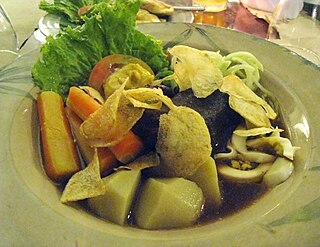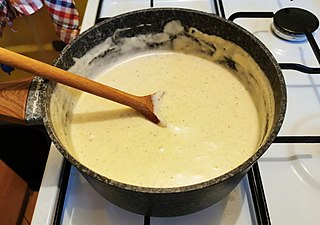
Dill is an annual herb in the celery family Apiaceae. It is the only species in the genus Anethum. Dill is grown widely in Eurasia, where its leaves and seeds are used as a herb or spice for flavouring food.

French cuisine consists of the cooking traditions and practices from France. Its cuisine has been influenced throughout the centuries by the many surrounding cultures of Spain, Italy, Switzerland, Germany and Belgium, in addition to its own food traditions on the long western coastlines of the Atlantic, the Channel and inland.

Chicken soup is a soup made from chicken, simmered in water, usually with various other ingredients. The classic chicken soup consists of a clear chicken broth, often with pieces of chicken or vegetables; common additions are pasta, noodles, dumplings, or grains such as rice and barley. Chicken soup has acquired the reputation of a folk remedy for colds and influenza, and in many countries is considered a comfort food.

Aioli, allioli or aïoli is a cold sauce consisting of an emulsion of garlic, salt, olive oil, and often egg; it is found in the cuisines of the northwest Mediterranean, from Andalusia to Calabria.

In cooking, a sauce is a liquid, cream, or semi-solid food, served on or used in preparing other foods. Most sauces are not normally consumed by themselves; they add flavor, moisture, and visual appeal to a dish. Sauce is a French word taken from the Latin salsa, meaning salted. Possibly the oldest recorded European sauce is garum, the fish sauce used by the Ancient Romans, while doubanjiang, the Chinese soy bean paste is mentioned in Rites of Zhou in the 3rd century BC.

Meatloaf is a dish of ground meat that has been combined with other ingredients and formed into the shape of a loaf, then baked or smoked. The final shape is either hand-formed on a baking tray, or pan-formed by cooking it in a loaf pan. It is usually made with ground beef, although ground lamb, pork, veal, venison, poultry, and seafood are also used, sometimes in combination. Vegetarian adaptations of meatloaf may use imitation meat or pulses.

Blanquette de veau is a French veal ragout in which neither the veal nor the butter is browned in the cooking process. To refrain from browning meat and fat in this way, is to cook them en blanquette.

Green sauce or greensauce is a family of cold, uncooked sauces based on chopped herbs, including the Spanish and Italian salsa verde, the French sauce verte, the German Grüne Soße or Frankfurter Grie Soß, the British mint sauce and greensauce, and the Argentinian chimichurri.

Rémoulade is a European cold sauce based on mayonnaise. Although similar to tartar sauce, it is often more yellowish, sometimes flavored with curry, and sometimes contains chopped pickles or piccalilli. It can also contain horseradish, paprika, anchovies, capers and a host of other items.

Deviled eggs are hard-boiled eggs that have been shelled, cut in half, and filled with a paste made from the egg yolks mixed with other ingredients such as mayonnaise and mustard. They are generally served cold as a side dish, appetizer or a main course during gatherings or parties. The dish's origin can be seen in recipes for boiled, seasoned eggs as far back as ancient Rome, where they were traditionally served as a first course. The dish is popular in Europe and North America.

Sabich or sabih is an Israeli sandwich of pita or laffa bread stuffed with fried eggplants, hard boiled eggs, chopped salad, parsley, amba and tahini sauce. Its ingredients are based on a traditional quick breakfast of Iraqi Jews and is traditionally made with laffa, which is nicknamed Iraqi pita. Sabich is sold in many businesses throughout Israel.

Fricassee or fricassée is a stew made with pieces of meat that have been browned in butter then served in a sauce flavoured with the cooking stock. Fricassee is usually made with chicken, veal or rabbit, with variations limited only by what ingredients the cook has at hand.

Uruguayan cuisine is a fusion of cuisines from several European countries, especially from Mediterranean foods from Spain, Italy, Portugal and France. Other influences on the cuisine resulted from immigration from countries such as Germany and Scotland. Uruguayan gastronomy is a result of immigration, rather than local Amerindian cuisine, because of late-19th and early 20th century inmigration waves of, mostly, Italians. Spanish influences are very abundant: desserts like churros, flan, ensaimadas yoo (Catalan sweet bread), and alfajores were all brought from Spain. There are also all kinds of stews known as guisos or estofados, arroces, and fabada. All of the guisos and traditional pucheros (stews) are also of Spanish origin. Uruguayan preparations of fish, such as dried salt cod (bacalao), calamari, and octopus, originate from the Basque and Galician regions, and also Portugal. Due to its strong Italian tradition, all of the famous Italian pasta dishes are present in Uruguay including ravioli, lasagne, tortellini, fettuccine, and the traditional gnocchi. Although the pasta can be served with many sauces, there is one special sauce that was created by Uruguayans. Caruso sauce is a pasta sauce made from double cream, meat, onions, ham and mushrooms. It is very popular with sorrentinos and agnolotti. Additionally, there is Germanic influence in Uruguayan cuisine as well, particularly in sweet dishes. The pastries known as bizcochos are Germanic in origin: croissants, known as medialunas, are the most popular of these, and can be found in two varieties: butter- and lard-based. Also German in origin are the Berlinese known as bolas de fraile, and the rolls called piononos. The facturas were re-christened with local names given the difficult German phonology, and usually Uruguayanized by the addition of a dulce de leche filling. Even dishes like chucrut (sauerkraut) have also made it into mainstream Uruguayan dishes.

Tunisian cuisine, the cuisine of Tunisia, consists of the cooking traditions, ingredients, recipes and techniques developed in Tunisia since antiquity. It is mainly a blend of Mediterranean and native Punics-Berber cuisine. Historically, Tunisian cuisine witnessed influence and exchanges with many cultures and nations like Italians, Andalusians, French and Arabs.

Selat solo is a Javanese dish influenced by Western cuisine; it is a specialty of Solo city, Central Java, Indonesia. It consists of braised beef tenderloin served in thin watery sauce made from a mixture of garlic, vinegar, kecap manis, Worcestershire sauce, water, and spiced with nutmeg and black pepper. It is served with hard boiled egg and vegetables such as string beans, potato, tomato, lettuce, cucumber, cauliflower or broccoli and carrot, and topped with potato chips and some dash of mustard, hollandaise or sauce gribiche on the side.

Jungguk-naengmyeon is a type of naengmyeon in Korean Chinese cuisine. The dish, consisting of icy cold broth with noodles, blanched seafood, fresh vegetables, and hard-boiled egg, is usually served with mustard and peanut sauce.
Poulette sauce is a classic sauce of French cuisine. It is made with mushrooms and allemande sauce, then finished with Noilly Prat, lemon juice, butter and chopped parsley.

In French cuisine, the mother sauces, also known as grandes sauces in French or leading sauces, are a group of sauces upon which many other sauces – "daughter sauces" or "small sauces" – are based. Different sets and classifications of mother sauces have been proposed since at least the early 19th century.

















